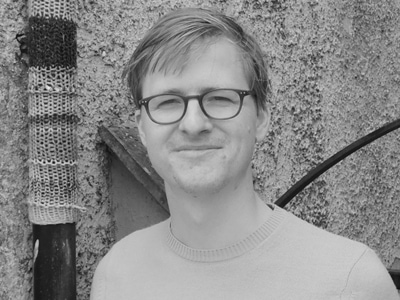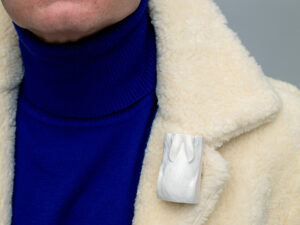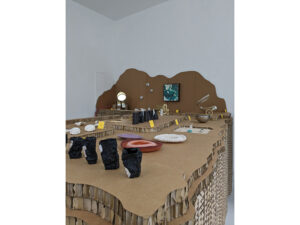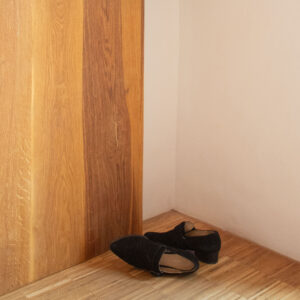
A Sense of Jewellery
September 15–November 19, 2015
Goldsmiths’ Center, London, UK
Curated by Amanda Game and Professor Dorothy Hogg, MBE
Comprehensive survey exhibitions of British studio jewelry are not common, but just like London buses you wait so long for one to show up and then two come along at the same time. This autumn in London, The Royal College of Art housed the Crafts Council’s touring exhibition I Am Here, featuring “98 pieces of studio jewellery by the most significant European makers from the last five decades,”[1] and, further east, a similar survey exhibition curated by Amanda Game and Professor Dorothy Hogg, MBE, entitled A Sense of Jewellery was held at The Goldsmiths’ Centre. My task was to review the latter, and after visiting The Goldsmiths’ Centre and having a taster of the I Am Here exhibition during COLLECT 2015 earlier on in the year, I am not sure if out of the two long-awaited buses I chose the right one.
A Sense of Jewellery was exhibited in the foyer of The Goldsmiths’ Centre. Usually given over to residencies, fairs, and training programs, this display was the first within the space to involve outside curators, external funds, and an exhibition-like feel. Seven cases surrounded by plywood panels sat in between a café, the reception desk, a security gate, and a couple of doors that led to meeting rooms or offices. It was a thoroughfare: the reception phone rang, a deliveryman brought in a package, the ambient music from the café and the violent slams of porterfilters emptied of their spent coffee drifted through to the gallery space, and on both of my visits I heard the bark of a dog: on one occasion from the café and on the other from a coiffed, bejewelled pooch that strode out of the security gates with its well-dressed owner.
All of this activity before you even set eyes upon the jewelry.
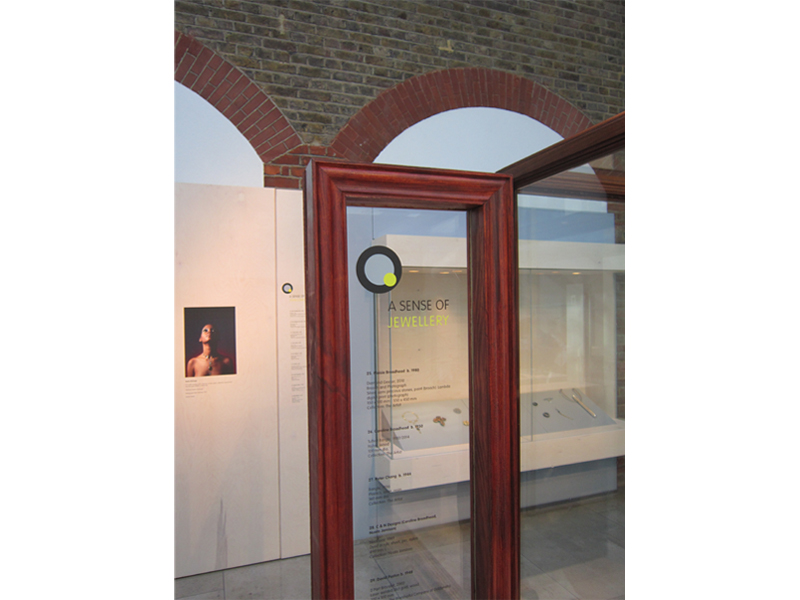
The show opens with a prologue: Sah Oved’s Life Began in Water, a piece from the 1950s combining gold, silver, jasper, aquamarine, and agates in an asymmetrical arrangement that is now in the collection of the Victoria and Albert Museum. The piece marked the start of the idea that jewelry can be art, a strong statement in a Britain reeling from the devastation and austerity of war. The piece undoubtedly has historical pedigree, but the curators opted for understatement. The wall panel stated:
This necklace shows an imaginative approach to materials and to sophisticated making and demonstrates a strong personal vision.
Nothing wrong here, but the text is far from spectacular and plays second fiddle to the objects. A loose approach to historical contextualization and a lack of a definite narrative arch was favored throughout the show, allowing visitors to approach objects without a mound of information. Wall panel and catalog texts, like the extract quoted above, often fell short of adding any sense of depth to the work.
Another wall panel alongside the prologue introduced the concepts of the show, namely to emphasize the quality and creativity of jewelry made in Britain in the post-war era by showing the work of independent makers. The objects were selected to show how makers have responded to “particular material, ideas or forms of jewellery” and demonstrate the influence of these objects and their makers both nationally and internationally.
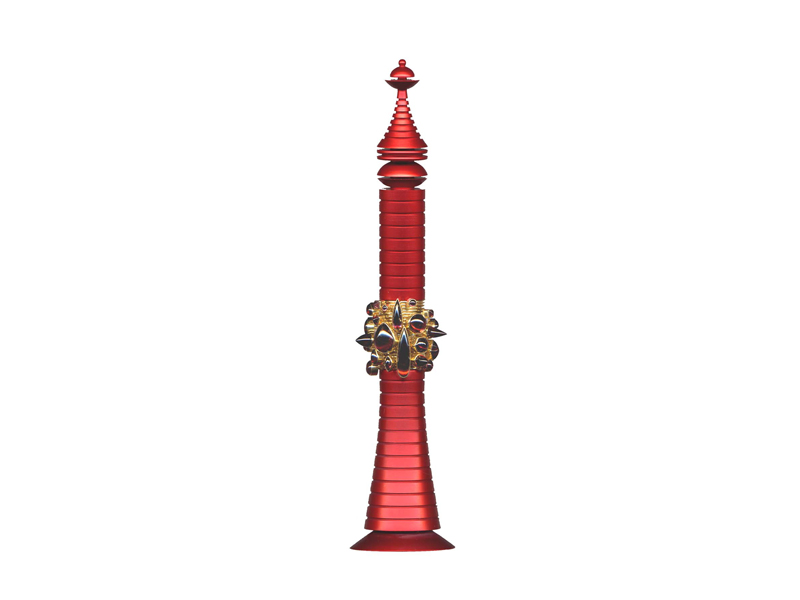
The curators made a good selection in terms of reflecting the breadth and diversity of British jewelry. The works in each of the seven display areas had a clear theme, although not explicitly stated in the wall panels and catalog. To the right as you enter there was a case populated by works of gold and silver, memorable for Esther Ward’s delicate Ladder Necklace (1998). In the main space, three more cases came into view. To the far left a case of color like no other: Susanna Heron’s bright bangles made in 1976 hung like halos over bright, exciting pieces such as Katy Hackney’s cutesy ring of cellulose acetate and silver, and Wendy Ramshaw’s The Red Queen (2001–2002), a surrogate finger, ring-holder, and the most powerful chess piece all rolled into one and colored in deep red. The case to the far right could have been called “sculptural jewelry.” David Watkins’s Flat Square Necklace (1977) with three narrow bands of gold punctuating the acrylic round-edged square spoke of precision geometry, contrasting with Maria Hanson’s big, mottled lump of steel on multiple wire cords and Elisabeth Frink’s heavy necklace that look like nutcracker pincers cast in bronze, with scuff marks from the process of making fully on show. In between the cases sat a handsome vitrine, the most conceptual part of the show, which I will return to in a bit.
Beyond this central body of the show were two further elements that led toward the security gate: a case of silver and platinum pieces, and, opposite, a tedious effort to incorporate a digital three-dimensional visualization of a ring. The instructions on the wall and the guidance to calibrate the 3D glasses to sense the ring behind a piece of Perspex caused my patience to expire within seconds, and I moved on, politely hanging the device back on its perch. This was a fairly uninspiring way to include digital technologies; it bordered on the tokenistic and reflected the generally conservative approach to the whole show. Jewelry in well-lit cases, pinned on gently slanting backboards. The plywood wall panels provided a motley array of information from QR codes that connected visitors with an iPhone to an interview with Gerda Flockinger on the British Library’s sound archive and quotes from private collectors outlining their love for the objects in their collections, to the fact that Jane Short’s brooch from 1990 in the silver and platinum case contained a design that was intended for a wafer box for Lichfield Cathedral. In terms of design and layout, jewelry exhibitions in London and the UK— with the exception of Gallery S O—rarely push the boundaries as much as their continental counterparts, adopting tried and tested methods instead.[2]

The jewelry in this exhibition veers toward but does not quite enter an expanded realm—all the work neatly fits within the constraints of necklace, ring, brooch, or bangle—and if you were looking for ground-breaking models of curation you will have probably left disappointed. Yet the objects sit together with a sense of ease, affording enough space for the visitor to make his or her own journey through the work, a surprising sense of calm given the mixture of processes on display. The setup and thematic placement of objects of different dates in close proximity meant questions like the division between the nonprecious and precious, a former schism within jewelry criticism, did not arise. We might want this easy-going, polite jewelry exhibition to push at some boundaries some more, ruffle the feathers of both a British jewelry world and broader culture that frequently opts for consensus over chaos. This did not happen; the dynamism of contemporary jewelry was only hinted at. One thing is for certain, however: the journey on my long-awaited bus was at least comfortable.
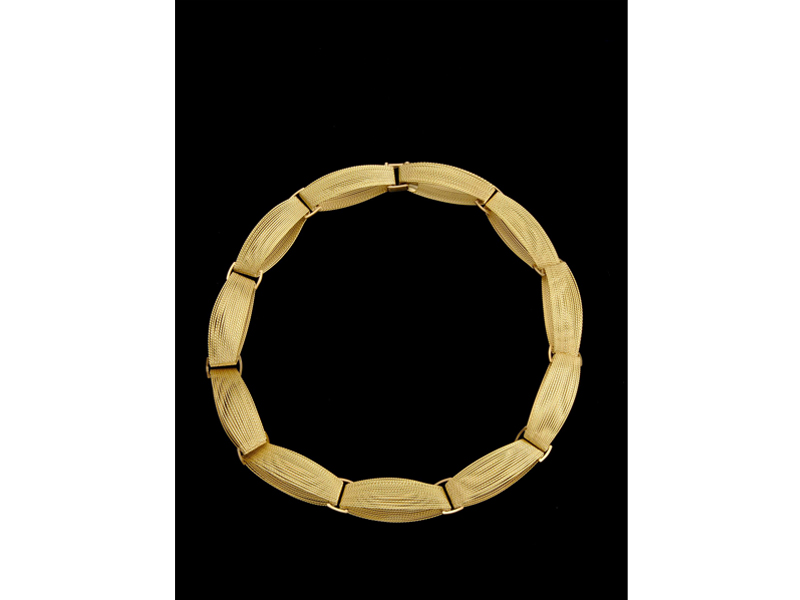

[1] “I Am Here: 9 November 2015 to 25 November 2015,” website of The Royal College of Art. Available at http://www.rca.ac.uk/news-and-events/events/i-am-here/ (accessed December 1, 2015).
